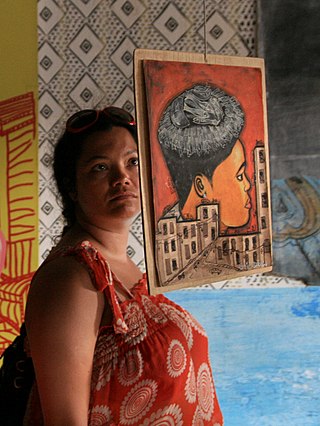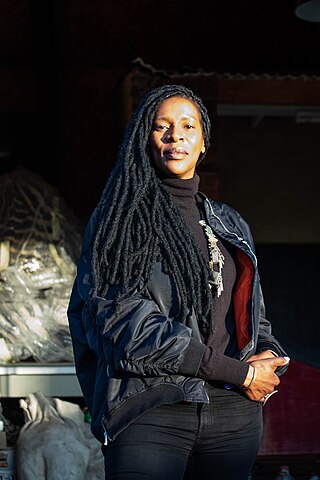David Goldblatt HonFRPS was a South African photographer noted for his portrayal of South Africa during the period of apartheid. After apartheid had ended he concentrated more on the country's landscapes. What differentiates Goldblatt's body of work from those of other anti-apartheid artists is that he photographed issues that went beyond the violent events of apartheid and reflected the conditions that led up to them. His forms of protest have a subtlety that traditional documentary photographs may lack: "[M]y dispassion was an attitude in which I tried to avoid easy judgments. . . . This resulted in a photography that appeared to be disengaged and apolitical, but which was in fact the opposite." He has numerous publications to his name.
Brett Murray is a South African artist mostly known for his steel and mixed media wall sculptures. He was born in Pretoria, South Africa. Murray has a master's degree in fine art from the Michaelis School of Fine Art, 1989. Referred to by critic Brenda Atkinson as "the dark prince of South African pop (art)", Murray is one of the country's most popular artists, often using easily recognisable media images with the addition of a subversive and bitterly funny twist. Murray's work addresses the wars of the cultures, the clash between Afrocentrism and Eurocentrism, the old and the new South Africas. "With my work I hope to critically entertain. Through satirical and tragic reflections on South Africa, I hope to shift people's perspectives and change people's minds, indulgent, arrogant and pretentious as this might sound," he says. More recently, his work has explored his own personal experiences and identity. Murray was also the founder of the sculpture department at Stellenbosch University.
Berni Searle is an artist who works with photography, video, and film to produce lens-based installations that stage narratives connected to history, identity, memory, and place. Often politically and socially engaged, her work also draws on universal emotions associated with vulnerability, loss and beauty.

Joburg Art Fair is a contemporary art fair held annually in Johannesburg, South Africa. The first show took place from 13 to 16 March 2008. The second Joburg Art Fair is scheduled for 3 April to 5 April 2009.

Tracey Rose is a South African artist who lives and works in Johannesburg. Rose is best known for her performances, video installations, and photographs.

Zanele Muholi is a South African artist and visual activist working in photography, video, and installation. Muholi's work focuses on race, gender and sexuality with a body of work that dates back to the early 2000s, documenting and celebrating the lives of South Africa's Black lesbian, gay, transgender, and intersex communities. Muholi is non-binary and uses they/them pronouns, explaining that "I'm just human".

Nandipha Mntambo is a South African artist who has become famous for her sculptures, videos and photographs that focus on human female body and identity by using natural, organic materials. Her art style has been self described as eclectic and androgynous. She is best known for her cowhide sculptures that connects the human form to nature.
Athi-Patra Ruga is a South African artist who uses performance, photography, video, textiles, and printmaking to explore notions of utopia and dystopia, material and memory. His work explores the body in relation to sensuality, culture, and ideology, often creating cultural hybrids. Themes such as sexuality,Xhosa culture, and the place of queerness within post-apartheid South Africa also permeate his work.
Doreen Southwood is a South African artist, designer, and boutique owner based in Cape Town. She works in a wide variety of media in her artwork, producing sculptures, objects, prints, film, and more, which she often bases on personal experiences and self exploration. Her candidness regarding personal flaws and the cycles of repression and coping that accompany conservative, middle class, Afrikaans upbringing inform much of her work, calling attention to ways in which women are silenced or otherwise repressed in that space.
Thelma van Rensburg is a South African artist. Her work explores female sexuality and how women are represented in the mass media concerning beauty or ugliness, issues of otherness and the Gaze. Her art making process is adventurous - ranging from mixed media, painting and drawing to digital work. She has been a participant in competitions such as Sasol New Signatures competition 2007 in Pretoria, Ekurhuleni competition in 2009 and Vuleka competition in 2009 in Cape Town and Art Lovers competition in Pretoria in 2014 and 2015 and was a finalist in all of these competitions.
Graeme Williams is a South African photographer known for both his photojournalism during the transition to democracy in South Africa and his documentary projects post-apartheid.

Julia Rosa Clark is a South African contemporary artist and educator known for her "graphically complex, textually coded and colour-rich paper installations."

Sue Williamson is an artist and writer based in Cape Town, South Africa.
Mary Sibande is a South African artist based in Johannesburg. Her art consists of sculptures, paintings, photography, and design. Sibande uses these mediums and techniques to help depict the human form and explore the construction of identity in a postcolonial South African context. In addition, Sibande focuses on using her work to show her personal experiences through Apartheid. Her art also attempts to critique stereotypical depictions of women, particularly black women.
iQhiya is a network of young black women artists based in Cape Town and Johannesburg, South Africa. They specialise in a broad range of artistic disciplines including performance art, video, photography, sculpture and other mediums.

Billie Zangewa is a half-Malawian, half-South African artist who hand sews silk fabrics to create collage tapestries, and who now lives in Johannesburg. Since 2004, her art has featured in international exhibitions including at the Paris Art Fair at the Grand Palais in Paris.

Jo Ractliffe is a South African photographer and teacher working in both Cape Town, where she was born, and Johannesburg, South Africa. She is considered among the most influential South African "social photographers."

Senzeni Marasela is a South African visual artist born in Thokoza who works across different media, combining performance, photography, video, prints, textiles, and embroidery in mixed-medium installations. She obtained a BA in Fine Arts at the Wits School of Arts, University of the Witwatersrand, Johannesburg in 1998. Her work is exhibited in South Africa, Europe, and the United States. It is part of local and international collections, including Museum of Modern Art or the Newark Museum, and is referenced in numerous academic papers, theses journals, and book publications.
Phumzile Khanyile is a South African photographer, living in Johannesburg. Her series Plastic Crowns is about women's lives and sexual politics. The series has been shown in group exhibitions at the Palace of the Dukes of Cadaval in Evora, Portugal; Iziko South African National Gallery in Cape Town; and the National Gallery of Victoria in Melbourne, Australia; and was a winner of the CAP Prize for Contemporary African Photography,
The Market Photo Workshop is a school of photography, a gallery, and a project space in Johannesburg, South Africa, founded in 1989 by David Goldblatt. It offers training in visual literacy for neglected and marginalized parts of South African society. Its courses are short foundation and intermediate, as well as longer advanced, and in photojournalism and documentary.







